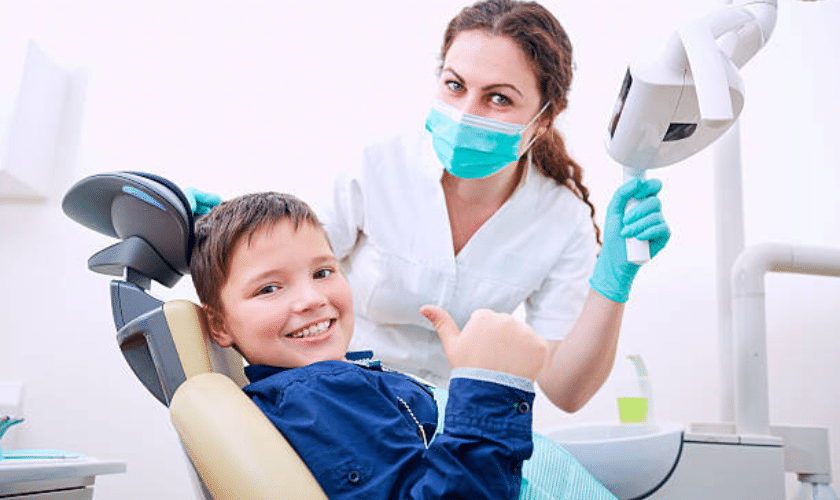Everything you need to know: Teeth Whitening options explained
Wiki Article
Understanding Common Dental Treatments: What Your Dental practitioner Can Do for You
Many individuals are not aware of the different oral procedures offered to them. Understanding these procedures can considerably affect dental health and wellness and total well-being. From regular cleanings to a lot more intricate treatments like origin canals, each solution plays a necessary role. People commonly overlook the significance of expert guidance in these matters. What certain treatments could improve your smile and address your special oral demands? Exploring these options may disclose shocking remedies.Regular Dental Cleanings
Routine oral cleanings are vital for maintaining optimal oral health. These preventative consultations, typically recommended every six months, aid eliminate plaque and tartar buildup that regular brushing and flossing may miss out on. Throughout a cleansing, a dental hygienist uses specialized devices to carefully clean teeth, making sure that both hard-to-reach areas and visible surface areas are addressed.This process not only advertises healthier gum tissues yet additionally minimizes the danger of dental caries and periodontal disease. Following the cleaning, a detailed examination by the dentist might determine early indications of prospective issues. Fluoride therapies are often used post-cleaning to reinforce enamel and secure against decay.
People might likewise get customized suggestions on improving dental hygiene routines. Overall, regular dental cleansings play a considerable duty in preventing oral issues and keeping a bright, healthy smile, reinforcing the relevance of routine visits to the dental professional.
Fillings for Dental caries
Fillings for dental caries are a common oral procedure intended at repairing tooth degeneration. Different loading materials, such as amalgam, composite material, and gold, offer various benefits and factors to consider. Understanding the filling up procedure and correct aftercare can help people maintain their oral wellness efficiently.Sorts Of Loading Products

Loading Procedure Overview
A cavity filling treatment usually involves several crucial actions to assure reliable treatment and person comfort. Initially, the dental practitioner will analyze the damaged tooth and may take X-rays to assess the degree of degeneration. Next, neighborhood anesthesia is administered to numb the area, making sure the client really feels marginal pain throughout the treatment. The dental professional after that utilizes specialized tools to get rid of the corroded portion of the tooth, cleaning up the dental caries completely. Afterward, the chosen loading material is placed, shaped, and brightened to bring back the tooth's feature and look. The dental expert offers instructions for post-treatment treatment and might arrange a follow-up consultation to keep track of the filling. This treatment assists avoid even more decay and preserves oral health and wellness.Aftercare and Maintenance Tips
Complying with the filling treatment, proper aftercare and maintenance are crucial for making sure the durability of the filling and the health and wellness of the tooth. People should prevent eating sticky or hard foods for a minimum of 1 day to permit the filling to establish effectively. Preserving excellent dental health is important; brushing two times daily and flossing consistently will aid prevent future decay. It is advisable to use a soft-bristle toothbrush to prevent annoying the dental filling. Furthermore, regular oral examinations are necessary, as dental professionals can keep track of the filling's condition and resolve any type of emerging concerns. They must consult their dental practitioner promptly to avoid difficulties if clients experience sensitivity or pain. Adhering to these standards can greatly boost the sturdiness of oral fillings.Root Canal Treatment
Root canal treatment is a common treatment created to save a tooth that is drastically decomposed or contaminated. During this procedure, a dentist gets rid of the contaminated pulp from the tooth's inside, which reduces pain and prevents more infection. After cleansing and decontaminating the hollow area, the dental professional loads it with a biocompatible material to seal the location. This procedure frequently needs 1 or 2 check outs, relying on the seriousness of the infection and the tooth's problem.Post-treatment, individuals may experience moderate pain, which is usually manageable with over-the-counter pain relievers. Appropriate oral health, including normal brushing and flossing, is essential for maintaining the health of the dealt with tooth. In most cases, a crown might be positioned on the tooth to recover its toughness and performance. Origin canal therapy successfully preserves all-natural teeth, adding to total dental wellness and stopping a lot more comprehensive procedures in the future.
Tooth Removals

Reasons for Tooth Removal
Oral removals are a common treatment in modern-day dentistry, commonly called for by numerous underlying concerns. One primary reason for extraction is severe dental cavity that compromises the stability of the tooth beyond repair service. Gum tissue illness can additionally bring about tooth flexibility, motivating the demand for extraction to avoid further problems. Additionally, overcrowding in the mouth may require the elimination of teeth to help with positioning, particularly before orthodontic treatment. Impacted knowledge teeth often need removal to ease pain and avoid infection. Sometimes, removal is essential for teeth that have actually experienced traumatic injury or cracks. Eventually, the decision for removal is made to assure general oral health and prevent complications that can impact bordering teeth and cells.The Removal Process
When a tooth extraction is regarded needed, the process typically starts with a comprehensive evaluation by the dental practitioner. This evaluation consists of assessing the individual's case history and carrying out a dental exam, usually gone along with by X-rays to determine the tooth's problem and its origins' framework. When the analysis is full, the dental practitioner will certainly describe the procedure, consisting of anesthetic choices to ensure the patient's convenience. The removal might be carried out using either a basic strategy for noticeable teeth or a medical method for affected teeth. After the tooth is gotten rid of, the dental professional will certainly offer guidelines concerning instant treatment and deal with any kind of potential problems. This cautious approach helps to ensure a smooth removal process and promotes ideal healing.Post-Extraction Treatment Tips
After a tooth removal, correct care is crucial for helping with healing and decreasing discomfort. Individuals must attack down delicately on a gauze pad for at least 30 minutes to manage bleeding and promote clot development. Cold pack can be related to the beyond the face to decrease swelling throughout the initial 1 day. It is suggested to prevent strenuous activities and to maintain the head raised to minimize swelling. Soft foods need to be eaten, and hot, spicy, or difficult foods ought to be stayed clear of for numerous days. Keeping oral health is vital; nonetheless, clients ought to avoid washing their mouths vigorously for the very first 24-hour. Complying with these standards can greatly boost healing and convenience after a tooth removal.Oral Crowns and Bridges
Although Teeth Whitening lots of people may not realize it, crowns and bridges are essential elements in corrective dental care that assist restore both function and aesthetics to harmed or missing out on teeth. Crowns, frequently described as caps, encase a damaged tooth to supply toughness and boost its appearance. They are typically made from materials such as porcelain, metal, or a combination of both, making certain durability and an all-natural look.Bridges, on the other hand, are utilized to change one or even more missing out on teeth by anchoring fabricated teeth to adjacent healthy and balanced teeth. This not only fills up the space yet also stops nearby teeth from moving, maintaining proper alignment. Both treatments call for cautious preparation and precise implementation by oral professionals, ensuring suitable results. Patients can anticipate enhanced dental function and enhanced smiles, making crowns and bridges vital choices for those looking for corrective dental options.
Teeth Lightening Options
Corrective dental care not only focuses on repairing harmed teeth but likewise on enhancing the total appearance of smiles, which brings teeth bleaching options into consideration (Teeth Whitening). Dental professionals use numerous approaches to achieve a brighter smile, including in-office therapies and at-home packagesIn-office bleaching makes use of high-concentration whitening agents, usually turned on by light, supplying prompt outcomes. This approach is managed by a dental professional, making certain safety and security and effectiveness. Conversely, at-home packages commonly contain lower focus of lightening representatives and require regular usage over a time period for visible results.
Additionally, dental professionals might supply custom trays for at-home applications, permitting for an extra customized approach. It is necessary for individuals to talk to their dental practitioner to establish the most suitable option based upon their oral history and individual choices (Pediatric Dentist). Eventually, teeth whitening can considerably improve aesthetics, enhancing positive self-image and general complete satisfaction with one's smile
Often Asked Inquiries
Just how Often Should I Visit the Dentist for Regular Exams?
A lot of oral professionals advise seeing the dental practitioner for routine check-ups every 6 months. This frequency aids to preserve oral health and wellness, enabling very early discovery of prospective concerns and prompt precautionary treatment to stay clear of more severe problems.What Are the Indicators I Need an Oral Procedure?
Indicators indicating the demand for a dental procedure consist of persistent tooth discomfort, level of sensitivity to chilly or hot, visible dental caries, swollen periodontals, foul-smelling breath, and problem chewing. Motivate interest can prevent additional complications and ensure dental health and wellness.Can Dental Procedures Be Done on Kid?
Yes, dental procedures can be executed on youngsters. Dental practitioners are trained to manage pediatric instances, guaranteeing that therapies are risk-free and ideal for a youngster's age and dental growth, resolving both preventive and restorative needs effectively.Are Dental Treatments Uncomfortable, and Just How Is Discomfort Managed?
Oral procedures can cause discomfort, however discomfort management techniques, such as regional anesthetic, sedation, and post-operative treatment, are employed to guarantee person comfort. A lot of individuals report workable levels of pain throughout and after therapy.What Should I Expect Throughout My First Oral Browse Through?
Throughout the first dental check out, individuals can anticipate an extensive exam, consisting of medical history review, oral X-rays, and a conversation of dental health. The dentist will certainly assess needs and outline potential therapy choices progressing.Tooth removals are a typical dental procedure performed for various reasons, such as extreme degeneration or congestion. One key factor for removal is serious tooth decay that endangers the honesty of the tooth past repair work. The extraction might be done utilizing either a simple technique for noticeable teeth or a surgical method for influenced teeth. Bridges, on the other hand, are utilized to replace one or even more missing teeth by securing fabricated teeth to nearby healthy teeth. Restorative dentistry not just focuses on fixing harmed teeth however additionally on improving the overall look of smiles, which brings teeth bleaching alternatives into consideration.
Report this wiki page